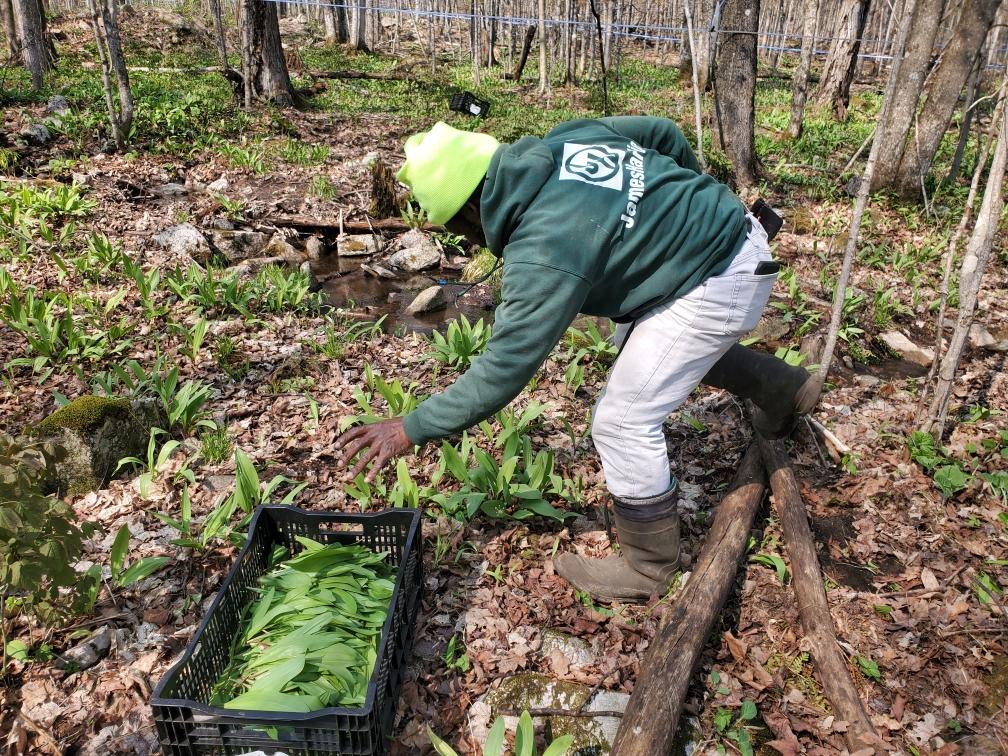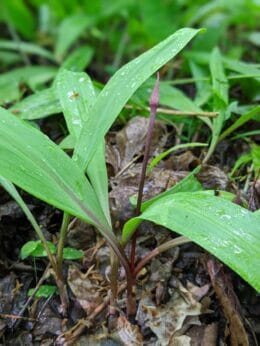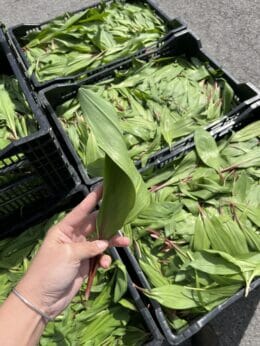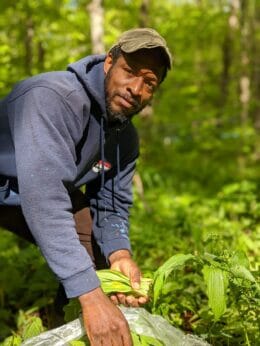For Ramps, A Sustainable Future Depends On Leaving The Bulb Behind
Ramps, a kind of wild onion, are foraged from forest floors. But amid growing popularity, there’s a right way and a wrong way to harvest.
For Ramps, A Sustainable Future Depends On Leaving The Bulb Behind
Ramps, a kind of wild onion, are foraged from forest floors. But amid growing popularity, there’s a right way and a wrong way to harvest.

Omar Thelwell harvests ramps by hand, cutting the leaves but leaving the bulbs.by Dan Tanski.
Ramps season has come to an end, and these wild onions have yet again faded from view after a brief frenzy of attention. A spring ephemeral species—so named because its harvest season lasts just a few weeks, from late March to early June—ramps are defined by their rarity. But for the plants, insects and animals that share their ecosystems in forested areas of the Northeastern United States and Southern Canada, their presence is vital year-round.
While Indigenous communities have gathered ramps for countless generations, the last two decades have seen a marked increase in people from all backgrounds seeking them out on forest floors, farmers market stands and restaurant menus. The widespread fascination with ramps reflects a growing general interest in local, seasonal ingredients that could positively impact our national food system; however, without a deeper awareness of sustainable foraging practices and the consequences of the climate crisis, it could do more harm than good.
Dr. Michelle Baumflek, a research biologist with the United States Department of Agriculture’s Forest Service, has been working with the Eastern Band of Cherokee Indians since 2016 while also collaborating on a long-term study of ramps pioneered by ecologist Dr. Joan Walker. Research from these collaborations indicates that the ramp populations in the southern Appalachian region have declined by about two percent in the past 20 years. That percentage may seem small, but the fallout could be felt in a big way in the region’s forests and beyond.

“Ramps play an important role in forest nutrient cycling,” Baumflek explains. “They take up nutrients in early spring as they grow, and when the leaves die back, they return some nutrients to the ecosystem. Ramps will flower after the leaves are done for the season—usually in June or July—and, at that time, they provide food for their pollinators, which include several species of bees.”
The recent decline in ramps is due to a variety of factors that may include both overharvesting and climate change. “Ramps are often found in rich cove habitat, which are relatively moist areas that have fertile organic soils,” says Baumflek. “Climate change may impact rich cove habitats in several ways, including shrinking cove habitats and increasing invasive species, which may affect ramps.”
While addressing the climate crisis requires large-scale change at the institutional level, the issue of overharvesting is something that can be resolved by educating individuals to be conscious consumers of ramps.
Unlike other popular foraged foods, such as mushrooms and even other types of onions, which may be ready to harvest in as little as two weeks, ramps take around seven years to reach maturity. Frequent foragers may see that the plants cannot keep pace with the dramatic rise in demand for ramps, but home cooks and restaurant chefs may not have this awareness.

Michael Farrell works with a small team of foragers that harvests ramps from 10,000 acres of forested land in New York and Vermont that he oversees as CEO of The Forest Farmers, an agroforestry business geared toward conserving mature forests while generating sustainable income for farmers. For a while, these ramps were sold at farmers markets in New York City, but, by 2020, Farrell grew concerned about depleting the ramps on this land. It was around this time that he began working with Ethan Frisch, co-founder of the spice company Burlap & Barrel, and forager Omar Thelwell.
“There are two different types of ramps here,” says Thelwell. “They’re all beautiful and fragrant and have green leaves, but the stems differentiate them—one is white and one is purple.”
Thelwell travels from his home in Jamaica each year to harvest ramps, apples and other crops in the US. As with most wild edible plants, ramps must be harvested by hand. “You bend down and with a knife or scissors, you cut the leaves. The bulb stays in the ground so that it grows back the next year,” says Thelwell. It is a simple process, but not common practice.

“Almost all the ramps that are sold in the marketplace come with the bulbs,” says Farrell. Imagine, for a moment, the last time you saw ramps—whether at a market or on Instagram—and you are likely to envision the full plant, from the fringe of roots at the base of the pale bulb all the way up the thin stem to the pointed tip of its leaf.
Ramps, as a member of the Allium family, are a perennial plant, meaning that their bulbs can produce new life each year, so long as they have the right growing conditions. Harvest just the leaves and the bulb will regrow the following spring, but take the whole bulb and you will not find any ramps on that patch of land again.
Although harvesting only the leaves is the most sustainable choice, people expect to buy the plant wholly intact, and without the bulbs, harvested leaves wilt quickly, which is less appealing to customers.
Farrell and Frisch worked together to address these problems by developing a unique method for harvesting and drying the ramps leaves, creating the first dried ramps product available for commercial retail.
“You get all the flavor and all the nutrition from the ramp greens,” says Farrell. “And we get to keep the forest full of ramps for decades to come.”
It is critical that all ramps enthusiasts adopt this longview mentality, along with an understanding that these wild onions may exist in the public eye for just a few weeks each year, but they must be allowed to exist in the forest all the other days of the year, too. For Baumflek, this also means recognizing the ecological and cultural importance of ramps and, when foraging, acting from a place of “respect and reciprocity—understanding that people are in relationship with ramps and with the forests in which they grow, and that we need to take care of each other.”
Follow us
This work is licensed under a Creative Commons Attribution-NoDerivatives 4.0 International License.
Want to republish a Modern Farmer story?
We are happy for Modern Farmer stories to be shared, and encourage you to republish our articles for your audience. When doing so, we ask that you follow these guidelines:
Please credit us and our writers
For the author byline, please use “Author Name, Modern Farmer.” At the top of our stories, if on the web, please include this text and link: “This story was originally published by Modern Farmer.”
Please make sure to include a link back to either our home page or the article URL.
At the bottom of the story, please include the following text:
“Modern Farmer is a nonprofit initiative dedicated to raising awareness and catalyzing action at the intersection of food, agriculture, and society. Read more at <link>Modern Farmer</link>.”
Use our widget
We’d like to be able to track our stories, so we ask that if you republish our content, you do so using our widget (located on the left hand side of the article). The HTML code has a built-in tracker that tells us the data and domain where the story was published, as well as view counts.
Check the image requirements
It’s your responsibility to confirm you're licensed to republish images in our articles. Some images, such as those from commercial providers, don't allow their images to be republished without permission or payment. Copyright terms are generally listed in the image caption and attribution. You are welcome to omit our images or substitute with your own. Charts and interactive graphics follow the same rules.
Don’t change too much. Or, ask us first.
Articles must be republished in their entirety. It’s okay to change references to time (“today” to “yesterday”) or location (“Iowa City, IA” to “here”). But please keep everything else the same.
If you feel strongly that a more material edit needs to be made, get in touch with us at [email protected]. We’re happy to discuss it with the original author, but we must have prior approval for changes before publication.
Special cases
Extracts. You may run the first few lines or paragraphs of the article and then say: “Read the full article at Modern Farmer” with a link back to the original article.
Quotes. You may quote authors provided you include a link back to the article URL.
Translations. These require writer approval. To inquire about translation of a Modern Farmer article, contact us at [email protected]
Signed consent / copyright release forms. These are not required, provided you are following these guidelines.
Print. Articles can be republished in print under these same rules, with the exception that you do not need to include the links.
Tag us
When sharing the story on social media, please tag us using the following: - Twitter (@ModFarm) - Facebook (@ModernFarmerMedia) - Instagram (@modfarm)
Use our content respectfully
Modern Farmer is a nonprofit and as such we share our content for free and in good faith in order to reach new audiences. Respectfully,
No selling ads against our stories. It’s okay to put our stories on pages with ads.
Don’t republish our material wholesale, or automatically; you need to select stories to be republished individually.
You have no rights to sell, license, syndicate, or otherwise represent yourself as the authorized owner of our material to any third parties. This means that you cannot actively publish or submit our work for syndication to third party platforms or apps like Apple News or Google News. We understand that publishers cannot fully control when certain third parties automatically summarize or crawl content from publishers’ own sites.
Keep in touch
We want to hear from you if you love Modern Farmer content, have a collaboration idea, or anything else to share. As a nonprofit outlet, we work in service of our community and are always open to comments, feedback, and ideas. Contact us at [email protected].by Elena Valeriote, Modern Farmer
June 28, 2023
Modern Farmer Weekly
Solutions Hub
Innovations, ideas and inspiration. Actionable solutions for a resilient food system.
ExploreExplore other topics
Share With Us
We want to hear from Modern Farmer readers who have thoughtful commentary, actionable solutions, or helpful ideas to share.
SubmitNecessary cookies are absolutely essential for the website to function properly. This category only includes cookies that ensures basic functionalities and security features of the website. These cookies do not store any personal information.
Any cookies that may not be particularly necessary for the website to function and are used specifically to collect user personal data via analytics, ads, other embedded contents are termed as non-necessary cookies.
As a farmer and harvester of ramps, I must say that sustainable harvest of the bulbs Is quite possible and when done at no more than 50%, seems to increase the overall size of the bulbs. Yes these ecosystems are valuable, but if we care for them and keep equipment out, protect the soil we can continue to have a bountiful harvest indefinitely.
This was very interesting! I had no idea that harvesting Ramps should ONLY involve the leaves if there are to be future Ramps.
Could they be grown commercially, so there would be replacement bulbs?